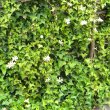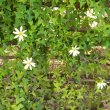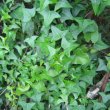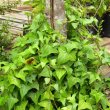| Botanical Name |
|
| Family |
Asteraceae - The daisy family. |
| Pronunciation |
sen-NEESH-shee-oh mac-roe-GLOS-sis |
| Common Name(s) |
English: Flowering Ivy; Cape Ivy; Natal Ivy
Afrikaans: Madeliefie-klimop
|
| Plant Group |
- Climber / Creeper Climber: a plant that climbs using tendrils or if given support.
Creeper: a plant running along the ground, often rooting as it goes.
- Ground Cover A plant with a low-growing, spreading habit, grown specifically to cover the ground.
- Perennial A plant whose life cycle lasts for three or more seasons.
|
| Plant Size |
- Medium
| Tree | 10m to 16m |
| Shrub | 1m to 2m |
| Perennial/ground cover | 40cm to 60cm |
| Bulb | 40cm to 60cm |
| Succulent | 40cm to 60cm |
|
| Position |
- Canopy Shade Canopy shade is found below closely grown trees where some light filters through. Ideal for the protection of herbaceous plants.
- Dry Shade Shady areas where soil has poor water retention or are dependent on rain for their moisture needs.
- Light or Dappled Shade Found below trees with sparse, open foliage. Ideal for the protection of herbaceous plants.
- Partial Shade The area is in shade for part of the day and in full sun for part of the day.
|
| General Information |
- Drought Tolerance: High The plant is well adapted to arid conditions; it can survive long periods of drought and high temperatures without extra water.
- Evergreen Plants that have leaves all year round.
- Frost: Tender A plant that will not survive any frost or low winter temperatures.
- Water Wise Plant species originating from low rainfall regions that require less water to survive and thrive than other plant species.
|
| Specific Information |
Flowering Ivy (no relation to exotic ivies) is a twining creeper with bright glossy green leaves that are slightly succulent. It will climb or hang up to two meters. When creeping along the ground, the stems develop roots at the nodes. Senecio macroglossus looks stunning mixed with blue plumbago as both flower at the same time.
|
| Ad Break |
|
| Flowers |
| Description |
|
| Season |
- All Year Plants will seldom bloom for the entire season as given in the list, but should flower during a period within these parameters.
- Summer Plants will seldom bloom for the entire season as given in the list, but should flower during a period within these parameters.
|
| Colour |
|
| Growth Rate |
- Fast Specifying growth rate can be very misleading as there is considerable variation of growth rate depending on type and species of plant, available water, supplementary feeding, mulching and general care, as well as the plants suitability and adaptability to the garden environment.
|
| Plant Uses |
- Attracts bees, butterflies or other insects This plant attracts insects which can be food for birds or other creatures in your garden.
- Attracts Birds This plant will attract birds.
- Boundary A plant useful for planting around the edges of the property to form a green or colourful backdrop, an impenetrable hedge, to hide walls or create privacy.
- Container Trees, shrubs and ornamental species that can adapt to growing in a restricted environment.
- Ground Cover Low-lying plants that spread fast, require minimal maintenance, and cover large expanses or bare areas between bulbs or shrubs. They provide protection from erosion and drought and improve the visual appearance of the garden.
- Retaining Walls Shallow rooted plants for cascading over dry stone walls or planting in hollow spots in retaining blocks.
- Stabilize Banks Plant is used to prevent soil erosion because their roots will form a mat that stabilizes the soil and keeps it from washing away in heavy rains.
- Suitable for coastal gardens Plants adapted to dry, sandy soil, forceful wind, limited rainfall and intense sunlight.
- Water Features These plants may have dramatic, lush foliage or graceful form. They do not shed excessive leaves and do not have invasive root systems.
- Wild Garden An indigenous garden planted for the benefit of wildlife and birds. Provides food, water, a variety of mini-biomes and no poisonous chemicals are used.
|
| Distribution and Habitat |
from Knysna in the Western Cape, through the Eastern Cape, north into Lesotho and on the KwaZulu-Natal south coast, in forest and thicket margins
|
| Planting Suggestions |
Plant in well-drained, rich garden soil and water regularly for best results. Use plenty of compost and mulch if the soil is not ideal. Senecio macroglossus is a good trellis plant against a wall but will need a little help in the beginning stages. It and can be also used for balconies, roof gardens and hanging pots. It makes a lush ground cover and is suitable for indoor cultivation.
|
| Medicinal Uses |
|
| Ad Break |
|








Discuss this plant
Share knowledge, ask a question or give an experience.